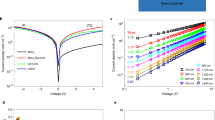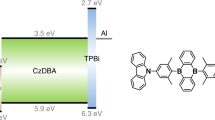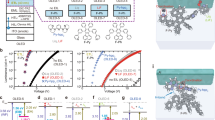Abstract
Organic light-emitting diode (OLED) technology is promising for applications in next-generation displays and lighting. However, it is difficult—especially in large-area mass production—to cover a large substrate uniformly with organic layers, and variations in thickness cause the formation of shunting paths between electrodes1,2, thereby lowering device production yield. To overcome this issue, thicker organic transport layers are desirable because they can cover particles and residue on substrates, but increasing their thickness increases the driving voltage because of the intrinsically low charge-carrier mobilities of organics. Chemical doping of organic layers increases their electrical conductivity and enables fabrication of thicker OLEDs3,4, but additional absorption bands originating from charge transfer appear5, reducing electroluminescence efficiency because of light absorption. Thick OLEDs made with organic single crystals have been demonstrated6, but are not practical for mass production. Therefore, an alternative method of fabricating thicker OLEDs is needed. Here we show that extraordinarily thick OLEDs can be fabricated by using the organic–inorganic perovskite methylammonium lead chloride, CH3NH3PbCl3 (MAPbCl3), instead of organics as the transport layers. Because MAPbCl3 films have high carrier mobilities and are transparent to visible light, we were able to increase the total thickness of MAPbCl3 transport layers to 2,000 nanometres—more than ten times the thickness of standard OLEDs—without requiring high voltage or reducing either internal electroluminescence quantum efficiency or operational durability. These findings will contribute towards a higher production yield of high-quality OLEDs, which may be used for other organic devices, such as lasers, solar cells, memory devices and sensors.
This is a preview of subscription content, access via your institution
Access options
Access Nature and 54 other Nature Portfolio journals
Get Nature+, our best-value online-access subscription
$29.99 / 30 days
cancel any time
Subscribe to this journal
Receive 51 print issues and online access
$199.00 per year
only $3.90 per issue
Buy this article
- Purchase on Springer Link
- Instant access to full article PDF
Prices may be subject to local taxes which are calculated during checkout



Similar content being viewed by others
Data availability
The data that support the findings of this study are available from the corresponding authors on reasonable request.
References
Tak, Y.-H., Kim, K.-B., Park, H.-G., Lee, K.-H. & Lee, J.-R. Criteria for ITO (indium–tin-oxide) thin film as the bottom electrode of an organic light emitting diode. Thin Solid Films 411, 12–16 (2002).
Ok, K.-H. et al. Ultra-thin and smooth transparent electrode for flexible and leakage-free organic light-emitting diodes. Sci. Rep. 5, 9464 (2015).
Yamamori, A., Adachi, C., Koyama, T. & Taniguchi, Y. Doped organic light emitting diodes having a 650-nm-thick hole transport layer. Appl. Phys. Lett. 72, 2147–2149 (1998).
Walzer, K., Maennig, B., Pfeiffer, M. & Leo, K. Highly efficient organic devices based on electrically doped transport layers. Chem. Rev. 107, 1233–1271 (2007).
Matsushima, T. et al. Interfacial charge transfer and charge generation in organic electronic devices. Org. Electron. 12, 520–528 (2011).
Nakanotani, H. & Adachi, C. Organic light-emitting diodes containing multilayers of organic single crystals. Appl. Phys. Lett. 96, 053301 (2010).
Comin, R. et al. Structural, optical, and electronic studies of wide-bandgap lead halide perovskites. J. Mater. Chem. C 3, 8839–8843 (2015).
Maculan, G. et al. CH3NH3PbCl3 single crystals: inverse temperature crystallization and visible-blind UV-photodetector. J. Phys. Chem. Lett. 6, 3781–3786 (2015).
Lampert, M. A. & Mark, P. Current Injection In Solids (Academic, 1970).
Naka, S., Okada, H., Onnagawa, H., Yamaguchi, Y. & Tsutsui, T. Carrier transport properties of organic materials for EL device operation. Synth. Met. 111–112, 331–333 (2000).
Tian, Y. et al. Solution-processed organometal halide perovskite hole transport layer for highly efficient organic light-emitting diodes. Adv. Electron. Mater. 2, 1600165 (2016).
Zhang, Y. et al. Efficient red phosphorescent organic light emitting diodes based on solution processed all-inorganic cesium lead halide perovskite as hole transporting layer. Org. Electron. 50, 411–417 (2017).
Wang, N. et al. Perovskite light-emitting diodes based on solution-processed self-organized multiple quantum wells. Nat. Photon. 10, 699–704 (2016).
Xiao, Z. et al. Efficient perovskite light-emitting diodes featuring nanometre-sized crystallites. Nat. Photon. 11, 108–115 (2017).
Liao, L.-S., Slusarek, W. K., Hatwar, T. K., Ricks, M. L. & Comfort, D. L. Tandem organic light-emitting diode using hexaazatriphenylene hexacarbonitrile in the intermediate connector. Adv. Mater. 20, 324–329 (2008).
Kim, B. S., Chae, H., Chung, H. K. & Cho, S. M. Electrical and optical analyses of tandem organic light-emitting diodes with organic charge-generation layer. AIP Adv. 8, 065303 (2018).
Peedikakkandy, L. & Bhargava, P. Composition dependent optical, structural and photoluminescence characteristics of cesium tin halide perovskites. RSC Adv. 6, 19857–19860 (2016).
Baldo, M. A., Lamansky, S., Burrows, P. E., Thompson, M. E. & Forrest, S. R. Very high-efficiency green organic light-emitting devices based on electrophosphorescence. Appl. Phys. Lett. 75, 4–6 (1999).
Uoyama, H., Goushi, K., Shizu, K., Nomura, H. & Adachi, C. Highly efficient organic light-emitting diodes from delayed fluorescence. Nature 492, 234–238 (2012).
Baldo, M. A., Adachi, C. & Forrest, S. R. Transient analysis of organic electrophosphorescence. II. Transient analysis of triplet-triplet annihilation. Phys. Rev. B 62, 10967–10977 (2000).
Masui, K., Nakanotani, H. & Adachi, C. Analysis of exciton annihilation in high-efficiency sky-blue organic light-emitting diodes with thermally activated delayed fluorescence. Org. Electron. 14, 2721–2726 (2013).
Cho, S.-H. et al. Weak-microcavity organic light-emitting diodes with improved light out-coupling. Opt. Express 16, 12632–12639 (2008).
Xie, G. et al. Measuring and structuring the spatial coherence length of organic light-emitting diodes. Laser Photonics Rev. 10, 82–90 (2016).
Lee, C. & Kim, J.-J. Enhanced light out-coupling of OLEDs with low haze by inserting randomly dispersed nanopillar arrays formed by lateral phase separation of polymer blends. Small 9, 3858–3863 (2013).
Kim, K.-H., Moon, C.-K., Lee, J.-H., Kim, S.-Y. & Kim, J.-J. Highly efficient organic light-emitting diodes with phosphorescent emitters having high quantum yield and horizontal orientation of transition dipole moments. Adv. Mater. 26, 3844–3847 (2014).
Frischeisen, J., Yokoyama, D., Adachi, C. & Brütting, W. Determination of molecular dipole orientation in doped fluorescent organic thin films by photoluminescence measurements. Appl. Phys. Lett. 96, 073302 (2010).
Leguy, A. M. A. et al. Experimental and theoretical optical properties of methylammonium lead halide perovskites. Nanoscale 8, 6317–6327 (2016).
Yokoyama, D., Sakaguchi, A., Suzuki, M. & Adachi, C. Horizontal molecular orientation in vacuum-deposited organic amorphous films of hole and electron transport materials. Appl. Phys. Lett. 93, 173302 (2008).
Nakahara, M. et al. Analysis of carrier traps in continuously operated 4,4′-bis[N-(1-naphthyl)-N-phenylamino]biphenyl/tris(8-hydroxyquinoline)aluminum-based organic light-emitting diodes by thermally stimulated current measurement. Jpn. J. Appl. Phys. 46, L636–L639 (2007).
Nakanotani, H., Masui, K., Nishide, J., Shibata, T. & Adachi, C. Promising operational stability of high-efficiency organic light-emitting diodes based on thermally activated delayed fluorescence. Sci. Rep. 3, 2127 (2013).
Acknowledgements
We thank M. Inoue and S. Hwang at Kyushu University for technical assistance and W. J. Potscavage Jr at Kyushu University for his assistance with the preparation of this manuscript. This work was supported by the Japan Science and Technology Agency, ERATO, Adachi Molecular Exciton Engineering Project (Japan Science and Technology Agency ERATO Grant Number JPMJER1305), by the International Institute for Carbon-Neutral Energy Research (WPI-I2CNER), by JSPS KAKENHI (grant numbers JP15K14149 and JP16H04192), and by The Canon Foundation.
Author information
Authors and Affiliations
Contributions
T.M., A.S.D.S., C.Q. and C.A. conceived the project. T.M., A.S.D.S. and C.Q. designed the architecture of the samples and fabricated the samples. T.M., T.K., A.S.D.S. and C.Q. evaluated the samples. F.B. and T.K. performed the optical simulations. T.M., F.B., T.K. and M.R.L. performed data analysis and figure preparation. All authors wrote the paper and discussed the results and commented on the manuscript.
Corresponding authors
Ethics declarations
Competing interests
: The authors declare no competing interests.
Additional information
Publisher’s note: Springer Nature remains neutral with regard to jurisdictional claims in published maps and institutional affiliations.
Extended data figures and tables
Extended Data Fig. 1 High-quality MAPbCl3 films fabricated on substrates.
a, X-ray diffraction pattern of a 50-nm-thick MAPbCl3 film vacuum-evaporated on a fused silica substrate. There were three diffraction peaks at 2θ values of 15.4°, 31.3° and 47.9°. These peaks can be assigned to the (1 0 0), (2 0 0), and (3 0 0) lattice planes of the cubic MAPbCl3 perovskite structure7,8. b, Atomic force microscope images of 50-nm-thick and 1,000-nm-thick MAPbCl3 films, which were vacuum-evaporated on glass substrates coated with a 100-nm-thick ITO layer and a 10-nm-thick MoOx layer. The corresponding root-mean-square roughnesses of the 50-nm-thick and 1,000-nm-thick films were 2.2 nm and 2.9 nm, respectively. c, Ultraviolet–visible absorption spectrum of a 50-nm-thick MAPbCl3 film vacuum-evaporated on a fused silica substrate. The spectrum agrees with literature data for a spin-coated MAPbCl3 film7. As can be seen in d and e, X-ray diffraction patterns and absorption spectra of vacuum-evaporated MAPbCl3 films were unchanged in air (about 24 °C and about 50% relative humidity) for 11 days. Excellent air stability has been reported in solution-processed MAPbCl3 films7.
Extended Data Fig. 2 Appropriate carrier injection barriers for fabricated devices.
a–e, Energy-level diagrams of hole-only (a) and electron-only (b) devices and OLEDs based on Alq3 (c), Ir(ppy)3 (d), 4CzIPN (d) and Ir(ppy)2acac (e). All energy levels are in units of electronvolts. The energy levels of all materials were measured using photoelectron yield spectroscopy and low-energy inverse photoemission spectroscopy. Only holes are transported through the hole-only devices because the Fermi level of MoOx lies below the valence band edge of MAPbCl3. Conversely, the Fermi level of Cs is above the conduction band edge of MAPbCl3, so only electrons are transported through the electron-only devices. The carrier injection barriers at the interfaces between MAPbCl3 layers and neighbouring layers should be small in the OLEDs used in this study.
Extended Data Fig. 3 Good reproducibility of device fabrication.
Histograms of driving voltages at 50 mA cm−2, maximum EQEs and 50% lifetimes (at which luminance reduces to half of the initial value) for Alq3-based, Ir(ppy)3-based and 4CzIPN-based OLEDs. The average values (AV) and standard deviations (SD) shown in each panel were calculated from at least four different batches of OLEDs fabricated under identical conditions for a total of 39–44 samples for each device architecture. The 50% lifetimes of Alq3-based devices were measured at a constant current of 50 mA cm−2 (see Fig. 2d). The 50% lifetimes of Ir(ppy)3-based and 4CzIPN-based devices were measured at a constant current for an initial luminance of 1,000 cd m−2 (see Extended Data Fig. 8c).
Extended Data Fig. 4 Angle-independent electroluminescence spectra in devices with 1,000-nm-thick perovskite transport layers.
a–f, Electroluminescence spectra measured at different angles for OLEDs with 50-nm-thick α-NPD and Alq3 transport layers (device A) (a) and MAPbCl3 transport layers (b–f) when operated at 10 mA cm−2. MAPbCl3 thicknesses were 50 nm (device B) (b), 250 nm (c), 500 nm (d), 750 nm (e) and 1,000 nm (device D) (f). An angle of 0° corresponds to the substrate-normal direction.
Extended Data Fig. 5 Reliable device fabrication with perovskite transport layers.
a, Thermally stimulated current profiles of devices A, B and D before degradation and after luminance reduced to half of the initial value. In this panel, peaks at around 105 K and around 130 K are signals of hole traps for α-NPD and electron traps for Alq3, respectively (see ref. 29). No signal from MAPbCl3 was detected. For the degraded devices, a new peak appeared at around 210 K. Since the degraded devices had slower voltage increases and exhibited weaker signals at around 210 K, these signals are associated with carrier traps, which are generated by Joule heating and cause voltages to increase during continuous device operation. The origin of these signals is unclear and still under investigation. b, Photographs of devices A, B and D operating at 50 mA cm−2. The top row shows fresh devices and the bottom row shows degraded devices. c, d, Current density versus voltage (c) and electroluminescence intensity versus voltage (d) curves for device D with 1,000-nm-thick MAPbCl3 transport layers, which were measured in consecutive forward and reverse scans using a silicon photodiode connected with a semiconductor parameter analyser (B1500A, Keysight). The current density–voltage–electroluminescence intensity curves were independent of the scan direction and speed.
Extended Data Fig. 6 Better device performance with perovskite transport layers than with organic transport layers.
a, Schematic architectures of OLEDs with HAT-CN, 50 wt%-Liq-doped ADB, or MAPbCl3 transport layers and chemical structures of HAT-CN, ADB and Liq. b, Ultraviolet–visible absorption spectra of 50-nm-thick HAT-CN and 50 wt%-Liq-doped ADB films. c, d, Current density versus voltage (c) and EQE versus current density (d) curves of OLEDs with HAT-CN HTLs. e, f, Current density versus voltage (e) and EQE versus current density (f) curves of OLEDs with Liq-doped ADB ETLs. No electroluminescence was observed from devices with the 1,000-nm-thick Liq-doped ADB ETL. g, h, Current density versus voltage (g) and EQE versus current density (h) curves of OLEDs with MAPbCl3 transport layers. i, j, Plots of voltages at 50 mA cm−2 (i) and maximum EQEs (j) as a function of total thickness of transport layers for OLEDs. The lack of voltage data in i for devices with the 1,000-nm-thick Liq-doped ADB ETL is because of device breakdown at a lower current. The error bars in i and j represent standard deviation values.
Extended Data Fig. 7 Perovskite transport layers are useful for industrial applications.
a–c, Schematic architectures (a) and current density versus voltage (b) and EQE versus current density (c) curves of OLEDs with MAPbCl3 or CsSnCl3 transport layers. The evaporation rate was 0.2 nm s−1 or 1.0 nm s−1 for MAPbCl3 and 0.2 nm s−1 for CsSnCl3. d, e, Ultraviolet–visible absorption spectrum (d) and X-ray diffraction pattern (e) of a 50-nm-thick CsSnCl3 film vacuum-evaporated on a fused silica substrate. The inset in d shows the atomic force microscope image of a 1,000-nm-thick CsSnCl3 film vacuum-evaporated on a glass substrate coated with a 100-nm-thick ITO layer and a 10-nm-thick MoOx layer. The root-mean-square roughness of this film was about 3.3 nm.
Extended Data Fig. 8 Good operational durability from thick devices with perovskite transport layers.
a–d, Schematic architectures (a) and current density versus voltage (b), luminance/initial luminance versus time (c), EQE versus current density (d) curves of Ir(ppy)3-based and 4CzIPN-based OLEDs with 1,000-nm-thick MAPbCl3 transport layers or 5-nm-thick Tris-PCz and 45-nm-thick BPy-TP2 transport layers. BPy-TP2 stands for 2,7-di(2,2′-bipyridin-5-yl)triphenylene, the chemical structure of which is shown in a. The data in b, d for thick devices were taken from Fig. 3a, b. The operational durability in c was obtained under a constant current flow at around 3 mA cm−2. The corresponding initial luminance was about 1,000 cd m−2 for thick devices and about 1,400 cd m−2 for thin devices. Increasing 4CzIPN doping concentration from 5 wt% to 15 wt% resulted in a marked increase of operational durability, which agrees with our previous results30. The solid curves in d are the results of fitting using a triplet–triplet annihilation model for Ir(ppy)3-based devices and using a model of singlet–triplet annihilation combined with triplet–triplet annihilation for 4CzIPN-based devices (see Methods for fitting details).
Extended Data Fig. 9 Incoherent light propagation in thick devices with perovskite transport layers.
a–c, Experimental and simulated electroluminescence spectra at the substrate normal direction for Alq3-based (device D) (a), Ir(ppy)3-based (b) and 4CzIPN-based (c) OLEDs with 1,000-nm-thick MAPbCl3 transport layers. The experimental electroluminescence spectra were measured at 10 mA cm−2. The simulated electroluminescence spectra were obtained under the assumption of coherent or incoherent light propagation. d, e, Angular dependence of electroluminescence peak wavelength (d) and intensity (e) for Ir(ppy)3-based and 4CzIPN-based OLEDs. An angle of 0° in d and e correspond to the substrate-normal direction. The solid lines in d and e indicate the results of the optical simulations.
Extended Data Fig. 10 Large dependence of LOE on transport layer thickness.
a–d, Calculated LOEs of Ir(ppy)3-based and 4CzIPN-based OLEDs with Tris-PCz and BPy-TP2 transport layers (a) and MAPbCl3 transport layers (b) and Alq3-based OLEDs with α-NPD and Alq3 transport layers (c) and MAPbCl3 transport layers (d). e, Angle-dependent photoluminescence intensities for mCBP films doped with 8 wt% Ir(ppy)3 or 5 wt% 4CzIPN. The solid line is the curve obtained by simulating a random dipole orientation. L1 and L2 are the HTL and ETL thicknesses, respectively.
Rights and permissions
About this article
Cite this article
Matsushima, T., Bencheikh, F., Komino, T. et al. High performance from extraordinarily thick organic light-emitting diodes. Nature 572, 502–506 (2019). https://doi.org/10.1038/s41586-019-1435-5
Received:
Accepted:
Published:
Issue Date:
DOI: https://doi.org/10.1038/s41586-019-1435-5
This article is cited by
-
High performance UV–vis–NIR photodetectors based on ZnO/organic–inorganic Sn–Pb hybrid perovskite heterojunction
Journal of Materials Science: Materials in Electronics (2024)
-
Far-infrared transparent conductors
Light: Science & Applications (2023)
-
Balancing the film strain of organic semiconductors for ultrastable organic transistors with a five-year lifetime
Nature Communications (2022)
-
Plasmonic–perovskite solar cells, light emitters, and sensors
Microsystems & Nanoengineering (2022)
-
Efficient and stable one-micrometre-thick organic light-emitting diodes
Nature Photonics (2022)
Comments
By submitting a comment you agree to abide by our Terms and Community Guidelines. If you find something abusive or that does not comply with our terms or guidelines please flag it as inappropriate.



